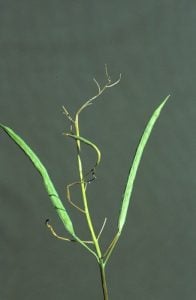Symptoms
Seedlings are attacked at ground level and in severe cases, rot though the stem.
Symptoms are similar to drought stress. Infected plants may be stunted, discoloured and have poor seed set. Fusarium wilt causes a discolouration of the stem, often seen as purple, grey or brown streaks starting from the foot region and moving up the plant. These symptoms are visible in stems cut lengthwise. Only one side of the plant or only a few branches may show symptoms.
One of the ways to determine if the disease is Fusarium wilt is to scrape or cut away the outer layer of the stem (epidermis). The presence of dark streaks inside the stem (in the vascular tissue) is characteristic of the disease. Infected plants often die prematurely and crop yield can be greatly reduced.
Organism
Furasium oxysporum f. sp. conglutinans
Host range
Cruciferous crops e.g. canola, cabbage and broccoli.
Method of spread
This pathogen can be spread with infected plants and seed, soil, equipment contaminated with soil, by water flow, and by wind. It can survive in the soil for many years in the absence of a host. In rare cases, seeds can become infected and possibly transmit the fungus. Many cruciferous crops and weeds may be symptomless, alternate hosts and have potential to transmit the pathogen as well.
Conditions favouring disease
Fusarium oxysporum f. sp. conglutinans can survive for many years in soil. Warm dry conditions may increase disease severity and yield loss.
Confused with?
Root rot, blackleg, and sclerotinia stem rot. Fusarium wilt can be differentiated from root rot because the roots of affected plants remain intact. Similarly, it differs from blackleg in that there is an absence of lodging and cankers on the stem base. Fusarium wilt differs from sclerotinia rot by the absence of bleaching and shredding of stems.
Where?
USA, Argentina and Canada.
Australia – Queensland and the Northern Territory.

Image 1. Fusarium wilt of canola seed head.
Source: Canola Council of Canada.


